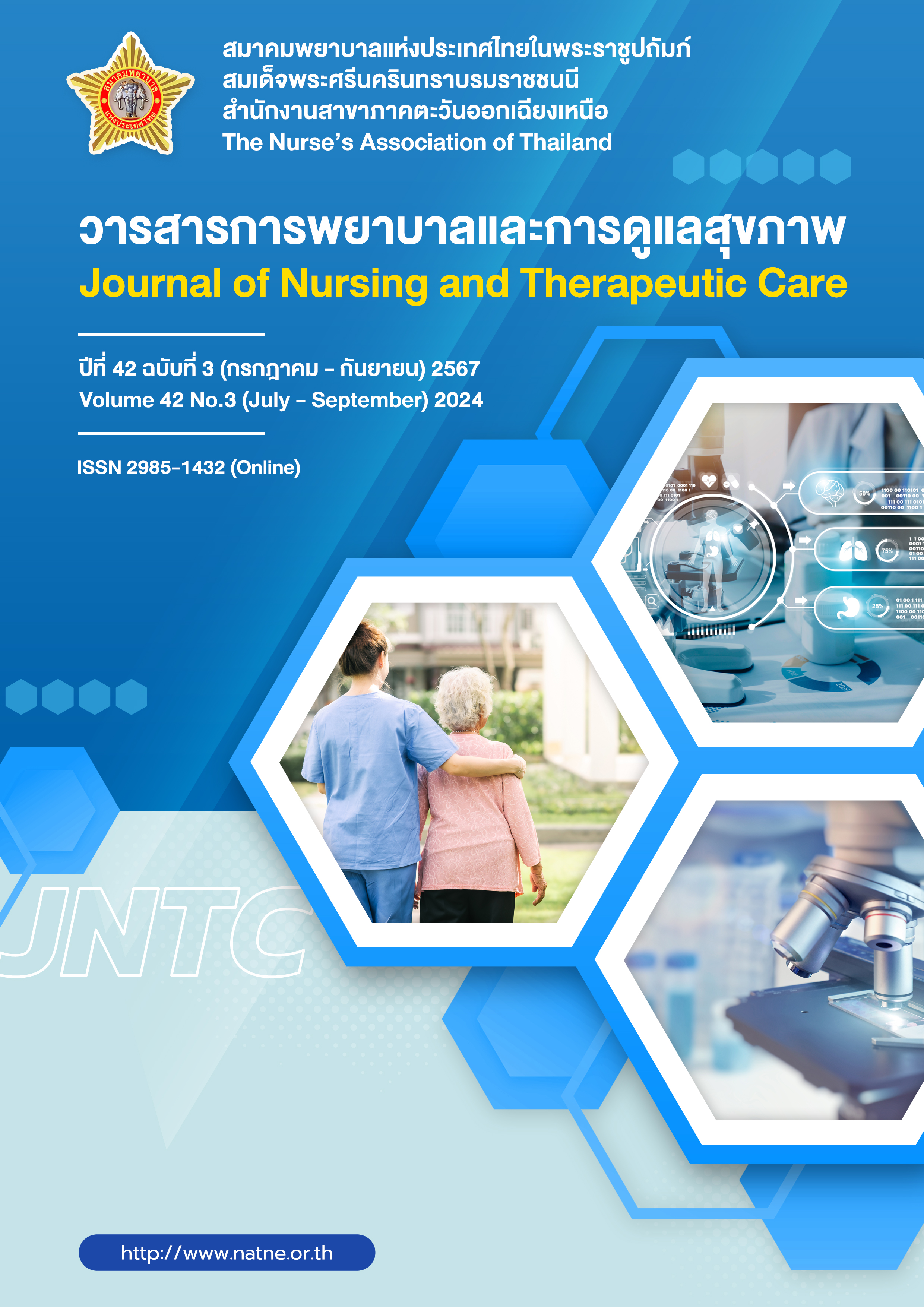การพัฒนาแนวปฏิบัติการพยาบาลสำหรับผู้ป่วยหลอดเลือดสมองแตกในหอผู้ป่วยหนักศัลยกรรมประสาท โรงพยาบาลร้อยเอ็ด
คำสำคัญ:
แนวปฏิบัติการพยาบาล, ผู้ป่วยหลอดเลือดสมองแตก, หอผู้ป่วยหนักศัลยกรรมประสาทบทคัดย่อ
การวิจัยและพัฒนานี้มีวัตถุประสงค์เพื่อพัฒนาแนวปฏิบัติการพยาบาลสำหรับผู้ป่วยหลอดเลือดสมองแตกในหอผู้ป่วยหนักศัลยกรรมประสาท โรงพยาบาลร้อยเอ็ด กลุ่มผู้ให้ข้อมูล 2 กลุ่มคือ ผู้ให้บริการ ได้แก่ พยาบาลและสหวิชาชีพ 37 คน ผู้รับบริการ ได้แก่ ผู้ป่วย 70 คนพร้อมผู้ดูแล แบ่งเป็น ระยะศึกษาสถานการณ์ 35 คน ใช้เก็บข้อมูลเชิงคุณภาพ 5 คน ใช้เป็นกลุ่มควบคุม 30 คน ระยะทดลองใช้แนวปฏิบัติ 5 คน ระยะประเมินผล 30 คน ดำเนินการวิจัย 4 ระยะคือ ศึกษาปัญหา พัฒนาแนวปฏิบัติทดลอง และประเมินผล เครื่องมือวิจัย ได้แก่ แนวคำถามสัมภาษณ์เชิงลึก สนทนากลุ่ม แบบประเมินความพึงพอใจต่อแนวปฏิบัติแบบสังเกตการใช้แนวปฏิบัติ แบบบันทึกภาวะแทรกซ้อน แบบทดสอบความรู้ วิเคราะห์ร้อยละ การเกิดภาวะแทรกซ้อนคะแนนความพึงพอใจ คะแนนการปฏิบัติ ใช้ค่าเฉลี่ย ส่วนเบี่ยงเบนมาตรฐาน เปรียบเทียบค่าเฉลี่ยคะแนนความรู้ของพยาบาลก่อนและหลังใช้แนวปฏิบัติ ด้วย Paired sample t-test และข้อมูลเชิงคุณภาพใช้การวิเคราะห์เชิงเนื้อหา
ผลการวิจัย พบสถานการณ์ปัญหา 1) ด้านผู้รับบริการ เกิดภาวะแทรกซ้อน ครอบครัวเครียด กังวล 2) ด้านผู้ให้บริการขาดแนวปฏิบัติการพยาบาลและการวัดผลลัพธ์ กระบวนการพัฒนา ได้แก่ ปลูกฝังจิตวิญญาณการแสวงหาความรู้ ตั้งคำถามตามรูปแบบ PICO ค้นหาหลักฐานที่ดีที่สุด ประเมินคุณภาพหลักฐาน บูรณาการหลักฐานยกร่างแนวปฏิบัติ ให้ผู้เชี่ยวชาญตรวจสอบ ได้คะแนนคุณภาพแนวปฏิบัติ ร้อยละ 91 ได้แนวปฏิบัติการพยาบาล 2 ระยะ คือ วิกฤตฉุกเฉินและฟื้นฟูสภาพ ประเมินผลพบว่า กลุ่มทดลอง ไม่เกิดภาวะแทรกซ้อนระยะที่สอง ร้อยละ 53.33 ส่วนที่เกิดร้อยละ 46.67 แต่ควบคุมได้ การนำใช้แนวปฏิบัติอยู่ในระดับมากที่สุด ความพึงพอใจของพยาบาลอยู่ในระดับมาก คะแนนความรู้ก่อนและหลังใช้แนวปฏิบัติแตกต่างกันอย่างมีนัยสำคัญทางสถิติ (p<.05)
Downloads
เอกสารอ้างอิง
Veerasarn K, editor. Care map for hemorrhagic stroke. Bangkok: Tanapress company limited; 2019. (in Thai)
Molhotra K, Zompola C, Theodorou A, Katsanos AH, Shoamanesh A, Gupta H. Prevalence, characteristics, and outcomes of undetermined intracerebral hemorrhage: a systematic review and meta-analysis. Stroke. 2021;52:3602-12.
Choi EY, Nieves GA, Jones DE. Acute stroke diagnosis. Am Fam family Physician. 2022;105(6):616-24.
Unnithan AKA, Das JM, Mehta P. Hemorrhagic stroke. [Internet]. 2023 [cited 2024 Feb 10]. Available from: https://www.ncbi.nlm.nih.gov/books/NBK559173/.
Pongcharoen C. Roles of nurse case manager in hemorrhagic stroke patients: a case study at Choapraya Yommarraj hospital. The journal of Boromarjonani College of Nursing Suphanburi. 2020;3(1):5-18. (in Thai)
Prachuablarp C. Increased intracranial pressure in patients with brain pathology: a dimension of evidence-based nursing practice. Thai Journal of Nursing Council. 2018;33(2):15-28. (in Thai)
Tu WJ, Zhao Z, Yin P, Cao L, Zeng J, Chen H. Estimated burden of stroke in China in 2020. JAMA Network open. 2023;6(3):e231455.
Li CY, Ma W, Liu KP, Yang JW, Wang XB, Wu Z, et al. Different ischemic duration and frequency of ischemic postconditioning affect neuroprotection in focal ischemic stroke. J Neurosci Methods. 2020;346:108921
Pongsavang S, Anpunya C, Poonsem S. Development of ABCs nursing practice guideline for acute hemorrhagic stroke patients in the surgical intensive acute unit at Chiang Mai Neurological Hospital. Journal of department of medical services. 2020;45(1):78-85. (in Thai)
Donabedian A. Evaluating the quality of medical care. Milbank Q. 2005;83(4):691-729.
Gustiani, S. Research and development (R&D) method as a model design in educational research and its alternatives. Holistics Journal. 2019;11(2):12-22.
Joanna Briggs Institute. Supporting document for the Joanna Briggs Institute levels of evidence and grades of recommendation [Internet]. 2014 [cited 2023 Nov 01] Available from: https://jbi.global/sites/default/files/2019-05/JBI%20Levels%20of%20Evidence%20Supporting%20Documents-v2.pdf.
Rukyingchareon K, Thaikla A, Suvarnakuta P. Use of the ABCs mnemonic concept in caring for patients with increased intracranial pressure. Journal of Nursing and Health Science Research. 2018;12(Supplement):12-9. (in Thai)
Sapsaard K, Chanruangvanich W, Thosingha O, Techapisut S. Outcomes of the application of polyvinyl alcohol towels to fever management in haemorrhagic stroke patients. Thai Journal of Nursing Council. 2016;31(2):109-22. (in Thai)
Pasukanthapak N, Borisut S, Pinyopaskul W, editors. Practice Guidelines for Stroke. Bangkok: Tanapress company limited; 2016. limited; 2016. (in Thai)
Khiewchaum R, Wattana C. Holistic nursing for traumatic brain injury patient. Journal of Phrapokklao Nursing College. 2017;28(1):129-39. (in Thai)
Sanchan M, Thongdornbom S. Pitfalls of nursing care in head injury patients with increased intracranial pressure.Journal of Public Health Nursing. 2021;35(2):139-53. (in Thai)
Kaewborisutsakul A. Capter 1. In: Kaewborisutsakul A, Phuenpathom N, editor. Pitfalls in the management of traumatic brain injury. Bangkok: Sahamit Pattana Printing (1992). 2023. P.9-25. (in Thai)
Heart and Stroke Foundation. Canadian stroke best practice recommendations management of spontaneous intracerebral hemorrhage seventh edition [Internet]. 2020 [cietd 2022 Oct 02]. Available from: https://www.strokebestpractices.ca/-/media/1-stroke-best-practices/management-of-intracerebral-hemorrhage/csbpr7-ich-module-final-eng oct2020.pdf?rev=2dcee5cbeda2418f828339 a43a531853.
Books C. Critical care nursing in acute postoperative neurosurgical patients. Crit Care Nurs Clin N Am. 2015;27(1):33-45.
de Oliveira Manoel AL, Goffi A, Zampieri FG, Turkel-Parrella D, Duggal A, Marotta TR, et al. The critical care management of spontaneous intracranial hemorrhage: a contemporary review. Crit Care. 2016;20:272.
Hussein MTEL, Zettel S, Suykens AM. The ABCs of managing increased intracranial pressure. J Nurs Educ Pract. 2017;7(4):6-14.
Stein KY, Froese L, Gomez A, Sainbhi AS, Nuray Vakitbilir N, Ibrahim Y, et al. Intracranial pressure monitoring and treatment thresholds in acute neural injury: a narrative review of the historical achievements, current state, and future perspectives. Neurotrauma Rep. 2023;4(1):478-94.
Hemphill JC, Greenberg SM, Anderson CS, Becker K, Bendok BR, Cushman M, et al. Guidelines for the management of spontaneous intracerebral hemorrhage a guideline for healthcare professionals from the American Heart Association/American Stroke Association. Stroke. 2015;46:2032-60.
Greenberg SM, Ziai WC, Cordonnier C, Dowlatshahi D, Francis B, Goldstein JN, et al. 2022 Guideline for the management of patients with spontaneous intracerebral hemorrhage: a guideline from the American Heart Association/American Stroke Association. Stroke; 2022;53:282-361.
Institute of Medical Research & Technology Assessment, Department of medical services, Ministry of Public Health. AGREE II AGREE next steps consortium [Internet]. 2556 [cited 2023 Nov 01]. Available from: http://www.imrta.dms.moph.go.th/imrta/images/AGREE%20ok%20for%20e-book.pdf. (in Thai)
Wanlopopworakit N. Effects of clinical nursing practice guidelines for acute ischemic stroke patients at Prachuap Khiri Khan Hospital. The Journal of Faculty of Nursing Burapha University. 2022;30(1):65-76. (in Thai)
Melnyk BM, Fineout-Overholt E, Stillwell SB, Williamson KM. Evidence-based practice in nursing & healthcare: a guide to best practice. Fifth edition. Philadelphia: Wolters Kluwer; 2023.
Eren F, Ozkan D, Elqutob O, Ozdemir G, Ozturk S. The evaluation of acute anxiety levels in caregivers of hospitalized stroke patients. Turk J Cereb Vasc Dis. 2024;30(1):22-9.
Ministry of public health. Twenty-year national strategic plan of public health (2017-2036). Ministry of public health F[Internet]. 2018. [cited 2024 Feb 06]. Available from: https://spd.moph.go.th/wp-content/uploads/2022/09/Ebook-MOPH-20-yrs-plan-2017-Final-Eng-120961.pdf. (in Thai)
Hotakasapkul K, Hannoke S, Haujaikeaw S, Sukpimai S. Effect of evidence-based nursing practice guidelines for monitoring and preventing deterioration due to complication in ruptured cerebral aneurysm patients. Journal of Nursing and Therapeutic Care. 2024;42(1):e268386. (in Thai)
Koykitjaroen W, Wongchunlachat W, Kitbunyounglers S. The development of nurse-led integrated care model for patients with traumatic brain injury. Thai Journal of Nursing and Midwifery Practice. 2019;6(2):48-69. (in Thai)
Oikarinen A, Kaariainen M, Mikkonen K, Tuomikoski AMA. Competence of healthcare professional in stroke care pathways sectional study. Journal of Vascular Nursing. 2024;42:115-25.
ดาวน์โหลด
เผยแพร่แล้ว
รูปแบบการอ้างอิง
ฉบับ
ประเภทบทความ
สัญญาอนุญาต
ลิขสิทธิ์ (c) 2024 วารสารการพยาบาลและการดูแลสุขภาพ

อนุญาตภายใต้เงื่อนไข Creative Commons Attribution-NonCommercial-NoDerivatives 4.0 International License.



